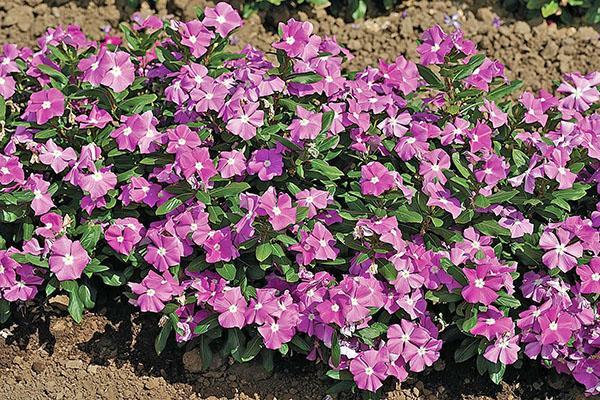Growing a catharanthus in the garden won't be a hassle
 Growing a catharanthus in the garden does not require much effort. This is an ornamental plant that belongs to the group of annual plants. A flower grows in the form of a bush or grass, which are abundantly covered with buds of a bright shade.
Growing a catharanthus in the garden does not require much effort. This is an ornamental plant that belongs to the group of annual plants. A flower grows in the form of a bush or grass, which are abundantly covered with buds of a bright shade.
Description of the plant

 Often, catharanthus is confused with balsam. The plant blooms colorfully, the buds are large. When loose, they grow up to 3 cm in diameter. The foliage is equally attractive. And all this due to the light streaks in the center.
Often, catharanthus is confused with balsam. The plant blooms colorfully, the buds are large. When loose, they grow up to 3 cm in diameter. The foliage is equally attractive. And all this due to the light streaks in the center.
Main types:
- Grape Cooler (bud color from light pink to red);

- Albus (a plant with snow-white flowers);

- Ocellatus (buds have a white tint and a red center);

- First Keys (this variety has 13 different colors);

- Aristocrat (buds in loose form are white, scarlet and pink).

There is also an ampelous type of catharanthus. It differs in long shoots, which look very impressive when in bloom. Due to their appearance, these plants are often used for hanging planters.
Growing and caring for ampelous catharanthus is slightly different from the usual type of plant.
Rules for the cultivation of catharanthus in open beds
 In regions where a temperate climate prevails, the shrub is ranked among indoor flowers. Although it can often be found in gardens. Due to its unpretentiousness, it is easy to decorate the landscape with this flower, but if you follow the basic rules for care.
In regions where a temperate climate prevails, the shrub is ranked among indoor flowers. Although it can often be found in gardens. Due to its unpretentiousness, it is easy to decorate the landscape with this flower, but if you follow the basic rules for care.
Where to grow a flower
 Before planting the catharanthus, you need to choose the right place for it. The site should be well warmed up by the sun and protected from drafts. These are important conditions that must be adhered to.
Before planting the catharanthus, you need to choose the right place for it. The site should be well warmed up by the sun and protected from drafts. These are important conditions that must be adhered to.
You can not plant a bush catharanthus on waterlogged soils with stagnant water, the flower will die from this.
Light and nutritious soil is most favorable for the plant. If there is no such on the site, then in the dimple where the flower will grow, it is necessary to add a little mixture with compost, river sand and peat.
Planting time sowing seeds
 The most popular cultivation method for this flower is seedling. To obtain it, seeds are sown in the middle of winter. Landing is carried out in shallow containers. It is necessary to immerse the grains to a depth of 1 to 2 cm.
The most popular cultivation method for this flower is seedling. To obtain it, seeds are sown in the middle of winter. Landing is carried out in shallow containers. It is necessary to immerse the grains to a depth of 1 to 2 cm.
To speed up germination, they equip a greenhouse from a polymer film or glass.
After planting, the containers are kept in a room where the temperature is maintained at about +250 C. After 2 or 3 weeks, when the first sprouts appear above the surface of the earth, the containers with them are moved to a cooler place. Light is important for the active growth of seedlings. Therefore, it is recommended to install a phytolamp near the flowerpot.
After the appearance of the third leaf, the seedlings are dived into individual containers.
It is important to remember about hardening the seedlings. For this, it is taken out into the fresh air (terrace, balcony). This should be done only when the weather is warm and calm outside. To get beautiful bushes, 10 cm sprouts need to be pinched.
The flower is planted in open ground after the soil warms up well. This is usually done in May, when the air temperature is kept within +200 FROM.
How to plant a catharanthus correctly
 The preparation of the flower bed consists in carefully digging up the soil, as well as adding a small amount of organic matter. Drainage (fine gravel or expanded clay) is laid out on the bottom of the formed pits, which is covered with a layer of earth.
The preparation of the flower bed consists in carefully digging up the soil, as well as adding a small amount of organic matter. Drainage (fine gravel or expanded clay) is laid out on the bottom of the formed pits, which is covered with a layer of earth.
Care rules after landing
 After moving the catharanthus to the flower bed, the soil around the plant should be regularly loosened and all weeds removed. Later, the flower itself will cope with them.
After moving the catharanthus to the flower bed, the soil around the plant should be regularly loosened and all weeds removed. Later, the flower itself will cope with them.
Watering mode and air humidity
 When irrigating a catharanthus, it is important to stick to moderate watering. The flower does not like when moisture stagnates in the soil. But even with its lack, it immediately begins to fold the leaves. On this basis, it is easy to understand that it is time to water it.
When irrigating a catharanthus, it is important to stick to moderate watering. The flower does not like when moisture stagnates in the soil. But even with its lack, it immediately begins to fold the leaves. On this basis, it is easy to understand that it is time to water it.
The delicate flower adores moist air. In the summer, especially during the hot period, it is sprayed every day or twice a day.
The bush does not like rainy weather with cool air. She oppresses the catharanthus, which causes the buds and flowers to fall off. If this weather persists, cover the plant with garden fiber, which is sold in a specialty store.
Top dressing
 For an active growing season, you should regularly fertilize the shrub, especially in the spring. Funds are deposited every 14 days. For this, drugs are used in liquid form. Top dressing is applied only at the root.
For an active growing season, you should regularly fertilize the shrub, especially in the spring. Funds are deposited every 14 days. For this, drugs are used in liquid form. Top dressing is applied only at the root.
The easiest way is to buy universal ready-made fertilizers for flowering plants for these purposes. Catharanthus reacts positively to the introduction of an ash solution into the soil at the rate of 100 g of dry agent for every 10 liters of water. Also, once a month, the bush is sprayed with Epin-Extra.
To avoid burns of the rhizome and harm to the flower, it is worth adhering to the dosage indicated on the package.
Shrub pruning
In the summer, there is no need to form a catharanthus, it grows itself, turning into a lush neat bush. Only yellow or damaged branches should be removed. This stimulates the plant to form new shoots.
Flower pests, diseases and control measures
Various parasites can settle on the plant: shield, mealybug. It also affects the whitefly flower and aphids. The first signs of the disease are manifested by whitish bloom or spotting on the foliage, its twisting, premature drying. Insecticides will help to destroy pests.
Organization of wintering
 Katarantus is a thermophilic crop that cannot survive the winter months outside. At the end of September, branches are cut off from the bushes, dug up and transplanted into large containers in a mixture of earth and sand. In winter they need to be kept in a room with an air temperature of about 160C. During this period, it is not recommended to water the flowers. With the onset of spring, the rhizome of the catharanthus is moved from the pots to the open beds.
Katarantus is a thermophilic crop that cannot survive the winter months outside. At the end of September, branches are cut off from the bushes, dug up and transplanted into large containers in a mixture of earth and sand. In winter they need to be kept in a room with an air temperature of about 160C. During this period, it is not recommended to water the flowers. With the onset of spring, the rhizome of the catharanthus is moved from the pots to the open beds.
Reproduction methods

You can propagate a shrub in one of three options:
- By dividing the bush. The procedure is carried out in the spring months at the same time as the flower is transplanted from the pot into the open ground. Taking into account the size of the plant and its rhizomes, each copy is divided into 2 or 3 parts.
- By cuttings. For these purposes, the tops cut off during spring cleaning are useful. They are simply buried in damp ground, where they take root.
- Sowing catharntus seeds. During the summer months, the seeds do not have time to fully ripen, therefore, to obtain planting material, the flower is grown in apartment conditions. Ready grains are harvested only in spring. For sowing seeds for seedlings, only nutrient soil is used, which is filled with boxes. Top seeds are covered with a substrate. Its ball should not exceed 1 cm.
Catharanthus is not only a garden decoration, it is also a useful flower. It is appreciated by healers and healers all over the world. They are treated for various diseases, even cancer. It is important to remember that the sap of the plant is poisonous, therefore shrubs are planted in beds that are inaccessible to babies.